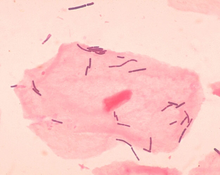
Lactobacillus

Lactobacillus is a genus of Gram-positive, facultative anaerobic or microaerophilic, rod-shaped, non-spore-forming bacteria. They are a major part of the lactic acid bacteria group (i.e., they convert sugars to lactic acid). In humans, they constitute a significant component of the microbiota at a number of body sites, such as the digestive system, urinary system, and genital system. In women of European ancestry, Lactobacillus species are normally a major part of the vaginal microbiota. Lactobacillus forms biofilms in the vaginal and gut microbiota, allowing them to persist during harsh environmental conditions and maintain ample populations. Lactobacillus exhibits a mutualistic relationship with the human body, as it protects the host against potential invasions by pathogens, and in turn, the host provides a source of nutrients. Lactobacillus is the most common probiotic found in food such as yogurt, and it is diverse in its application to maintain human well-being, as it can help treat diarrhea, vaginal infections, and skin disorders such as eczema. Many lactobacilli operate using homofermentative metabolism (they produce only lactic acid from sugars), and some species use heterofermentative metabolism (they can produce either alcohol or lactic acid from sugars). They are aerotolerant despite the complete absence of a respiratory chain. This aerotolerance is manganese-dependent and has been explored (and explained) in Lactobacillus plantarum. Many species of this genus do not require iron for growth and have an extremely high hydrogen peroxide tolerance. The genomes of Lactobacillus are highly variable, ranging in size from 1.2 to 4.9 Mb (megabases). Accordingly, the number of protein-coding genes ranges from 1,267 to about 4,758 genes (in L. sanfranciscensis and L. parakefiri, respectively). Even within a single species there can be substantial variation. For instance, strains of L. crispatus have genome sizes ranging from 1.83 to 2.7 Mb, or 1,839 to 2,688 open reading frames. Lactobacillus contains a wealth of compound microsatellites in the coding region of the genome, which are imperfect and have variant motifs. The genus Lactobacillus currently contains over 180 species and encompasses a wide variety of organisms. The genus is polyphyletic, with the genus Pediococcus dividing the L. casei group, and the species L. acidophilus, L. salivarius, and L. reuteri being representatives of three distinct subclades. The genus Paralactobacillus falls within the L. salivarius group. In recent years, other members of the genus Lactobacillus (formerly known as the Leuconostoc branch of Lactobacillus) have been reclassified into the genera Atopobium, Carnobacterium, Weissella, Oenococcus, and Leuconostoc. More recently, the Pediococcus species P. dextrinicus has been reclassified as a Lactobacillus species. According to metabolism, Lactobacillus species can be divided into three groups: The female genital tract is one of the principal colonisation sites for human microbiota, and there is interest in the relationship between the composition of these bacteria and human health, with a domination by a single species being correlated with general welfare and good outcomes in pregnancy. In around 70% of women, a Lactobacillus species is dominant, although that has been found to vary between American women of European origin and those of African origin, the latter group tending to have more diverse vaginal microbiota. Similar differences have also been identified in comparisons between Belgian and Tanzanian women. Lactobacillus species produce hydrogen peroxide which inhibits the growth and virulence of the fungal pathogen Candida albicans in vitro and in vivo. In vitro studies have also shown that Lactobacillus sp. reduce the pathogenicity of C. albicans through the production of organic acids and certain metabolites. Both the presence of metabolites, such as sodium butyrate, and the decrease in environmental pH caused by the organic acids reduce the growth of hypha in C. albicans, which reduces its pathogenicity. Lactobacillus sp. also reduce the pathogenicity of C. albicans by reducing C. albicans biofilm formation. Biofilm formation is reduced by both the competition from Lactobacillus sp., and the formation of defective biofilms which is linked to the reduced hypha growth mentioned earlier. On the other hand, following antibiotic therapy, certain Candida species can suppress the regrowth of Lactobacillus sp. at body sites where they cohabitate, such as in the gastrointestinal tract. In addition to its effects on C. albicans, Lactobacillus sp. also interact with other pathogens. For example, Lactobacillus reuteri can inhibit the growth of many different bacterial species by using glycerol to produce the antimicrobial substance called reuterin. Another example is Lactobacillus salivarius, which interacts with many pathogens through the production of salivaricin B, a bacteriocin.
